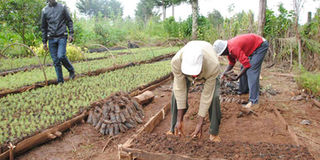For the love of trees

Patrick Bett's farm in Keringet, Kuresoi South in Nakuru where he grows and sells seedlings. The farmer started planting trees after completing high school. PHOTO | JOHN NJOROGE | NATION MEDIA GROUP
What you need to know:
- Tree planting has been part of Bett’s life for the last 13 years, having learned the art from his father, a Kenya Forest Service officer.
- For Cypress seedlings, they are ready for market four months after potting. However, for the indigenous trees like Red Cedar, one waits up to seven months.
- Another challenge is heavy rains that occasionally wash away the seedlings in the nursery or those that have been potted some days to the rainfall.
- It is easy to maintain seedlings during the rainy season
About an hour’s drive from Molo in Kuresoi Constituency sits Patrick Bett’s beautiful tree seedlings farm.
The half-acre farm that hosts 250,000 seedlings of different varieties is a sight to behold.
Lining the driveway are neatly arranged seedlings at various stages of growth.
“I grow 10 varieties of seedlings among them cedar, Olea Africana, Prunus Africana, Dombeya, Rosewood and Nandi flame,” says Bett, 32, who holds a Diploma in Hotel Management.
Other trees include cypress, blue gum, pine and jacaranda trees.
Tree planting has been part of Bett’s life for the last 13 years, having learned the art from his father, a Kenya Forest Service officer.
The farmer started planting trees after high school but it did not occur to him that he could do it on large-scale.
Besides, his sights were trained on a white collar job.
“After college I worked at the Lake Nakuru National Park as a tour guide for two years, but I resigned in 2011 and decided to expand the tree planting business.”
With Sh30,000 from his savings, Bett visited the Kenya Forest Service offices in Londiani, Kericho County and purchased tree seedlings of various trees.
A kilo of Cypress seeds go for Sh5,000, Blue gum Sh6,000, Pine Sh7,000 and Dombeya Sh5,000.
“I was lucky because about that time there was high demand for trees as the government and environmental organisations were pushing for the reforestation of Mau Forest. I sold the trees at between Sh20 and Sh300 each.”
It takes him an average of seven months to grow the seeds to reach the stage of selling.
“I buy certified seeds from the Kenya Forest Research Training Institute (Kefri), a department of the Kenya Forest Service in Londiani. Sometimes if they do not have seeds, I place the order from the headquarters in Nairobi.”
Once he gets the seeds, he raises them in nursery beds, where they take one month to germinate and sprout.
“After a month I do pricking out, which is picking the mature seedlings and potting them in bags before they are transferred to blocks.”
PROFITABLE AGRIBUSINESS
The standard size of a block is 20m by 2m. This hosts 20,000 tree seedlings. He top-dresses the seedlings with CAN fertiliser which helps them grow faster and have a green foliage.
The fertiliser is added at pricking out stage.
For Cypress seedlings, they are ready for market four months after potting. However, for the indigenous trees like Red Cedar, one waits up to seven months. Although planting is not limited to a specific season, Bett says it is easier to maintain the seedling during the rainy season.
However, he notes that it is advisable to plant all-year round to have a continuous supply of tree seedlings throughout.
Bett, who also farms maize on eight acres, earns at least Sh100,000 on a bad month from supplying tree seedlings, to among others, county governments and farmers.
The seedlings go for between Sh20 and Sh300 depending on the type of the tree and the size.
For instance, Red cedar goes from Sh20 to Sh100, Prunus Africana from Sh20-Sh50 and Rosewood from Sh30-Sh300.
His biggest and most memorable job is the beautification of the Kenyatta Avenue along the Kericho-Nakuru highway in Nakuru town.
“I mainly advertise by word of mouth and get other business through referrals. The business is good since one gets tenders from various organisations.” But the lucrative nature of the business has attracted thieves who crawl into his garden at night and make away with seedlings.
Another challenge is heavy rains that occasionally wash away the seedlings in the nursery or those that have been potted some days to the rainfall.
Patrick Ooro, an agronomist at Kalro, says some trees like Barbary host alternative diseases like the stem rust, therefore, a farmer should be careful in case they are growing other crops.
However, Ooro notes trees are a good business because diseases are rare.




